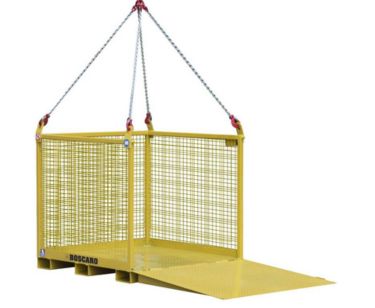Top Eight Reasons to Use A Concrete Bucket
We’re talking about a concrete bucket under the hook of a crane, whether a tower crane or a mobile crane. Either way, these buckets are most likely to be seen on big construction sites where there are multiple delivery systems being utilized to bring concrete to where it needs to go, which includes everything from wheelbarrows to advanced pumping systems. However, no matter how complex the job, concrete buckets are essential…

8. Because they hold a lot of concrete
A lot more than a shovel. A lot more than a wheelbarrow. A small concrete bucket holds just over half a cubic yard of concrete, which is equivalent to 5-6 wheelbarrow loads. But the big concrete buckets hold more than two-and-a-half cubic yards, which is equal to about 30 wheelbarrow loads. Whether pouring walls, footings, or pilings, a concrete bucket can carry large amounts of concrete to a specific location.
7. Because they are mobile
They go wherever a crane will take them. So, depending on the capacity and reach of your crane, the concrete buckets will go wherever they need to go, including where trucks cannot drive and even where pumps cannot reach. Concrete buckets under the hook of a crane allow for maximum flexibility of placement.

6. Because they are easy to use
Whether you use the manually operated version or the remote controlled, and whether you’re on the ground or the bucket is suspended, you’ve got complete control to not only place the concrete where it needs to go, but also to regulate the rate of discharge, especially when your bucket comes with an auto-closing spring gate system. Due to its cone-shaped design (and with gravity as your friend), a concrete bucket allows you to discharge your material with ease and precision.
5. Because they are safe
When your concrete bucket is in good working condition and you’re abiding by sound rigging practices, concrete buckets are simple and safe to use. Compared to other delivery systems, onsite risks are seriously mitigated due to the fact that buckets allow for fewer moving parts and fewer people that are handling heavy material and equipment. It’s the crane that does the heavy lifting and usually only one person is required to command the remote control or bucket handle.

4. Because they require less time and less labor
Imagine five guys with wheelbarrows cruising around a worksite, back and forth from the concrete truck to their pouring destination. Too many people. Too much time. Then imagine a concrete bucket gliding through the air under the hook of a crane: the bucket operator and crane operator cooperate to perform the simple task. This is exactly why we have cranes on the work site and why concrete buckets are so useful.
3. Because they cost less than pumping
For big concrete jobs, of course, concrete pumping is fast, efficient, and cost-effective.
But it has its limitations and weaknesses. For the smaller, harder-to-reach jobs, moving concrete in buckets costs less and makes more sense. Even on job sites that depend on pumping for much of the work, concrete buckets are inevitably required to fill the gaps in the overall placement strategy.

2. Because they reach farther and higher
Many people do not realize that even the most advanced concrete pumping systems have their limitations, in terms of reach. When the distance from the pump is too far, or when the vertical height is too high, or when powerlines complicate matters, pumping is inadequate, and a concrete bucket at the end of a crane becomes the only way to get larger amounts of concrete where they absolutely need to go.
1. Because they do more than concrete
Although the bucket was designed for concrete, the sky is the limit in terms of other creative uses of this durable and versatile piece of equipment. We’ve heard about how these buckets have been used for delivering pea gravel, landscape material, and all manner of flocculants. We even saw a bucket at a party once releasing hundreds of golf balls for a prize draw!
Conclusion
Concrete buckets are a good investment. When it comes to placing concrete, leave the really small jobs for the wheelbarrows and leave the really big jobs for pumping, but leave the rest for concrete buckets. There are many cases when they make the most sense. Even on big construction sites, concrete buckets provide a vital complement to pumping. That’s why, for concrete placement professionals who work on big construction sites, concrete buckets are an essential part of their toolkit.




